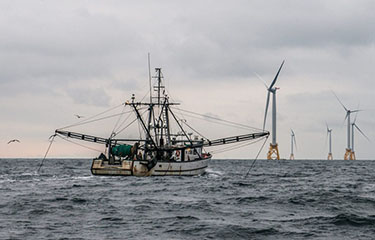A sweeping new report compiled in partnership between the commercial fishing industry and federal agencies summarizes the massive changes that offshore wind development could bring to U.S. fisheries.
At 388 pages, the “Synthesis of the Science” report covers what is known so far about the likely effects of building potentially thousands of wind turbines off the U.S. coasts.
The topics are wide-ranging: how fishermen may be displaced from traditional fishing grounds, whether electromagnetic fields around power cables change fish behavior, and how turbines could alter oceanographic conditions.
But what’s most striking about the paper is its descriptions of data gaps and the need for much more research, even as the federal Bureau of Ocean Energy Management and state governments press forward with wind power planning.
One typical passage sums up how development plans for offshore wind – abbreviated as OSW in the parlance of planners – are outracing the state of ocean science:
“The recommendations indicate an enormous amount of research is still needed in order to understand the impact of OSW on our environment and fisheries, but time is limited. A timely, productive regional science plan for offshore wind could have resulted in an enhanced ability to understand the environmental interactions resulting from the first large-scale OSW projects, especially on a cumulative scale.”
The cumulative effects of Atlantic offshore projects already in the works – from southern New England to the Carolinas – is a recurring theme in the paper.
“The fishing industry in the U.S. is highly concerned with the quality of cumulative impacts assessments currently being conducted for OSW development. BOEM’s current approach is to analyze projects on an individual basis. The environmental and economic effects will not be isolated, and fishing communities have suggested the scale of analysis should match that of fisheries and ecosystem management practices.”
The report compiles findings initiated in 2020 when the Responsible Offshore Development Alliance, a coalition of fishing industry groups, the National Oceanic and Atmospheric Administration and BOEM convened a national workshop to examine “the current state of science relevant to fisheries and offshore wind energy interactions.”
The event was held in October 2020 via an online Zoom conference that attracted over 550 participants, according to RODA. Funded by NOAA’s Northeast Fisheries Science Center, the symposium and its final report reflects contributions from fishermen, fishing industry representatives, federal and state agencies, wind developers, and scientists from the U.S. and Europe.
The report was peer-reviewed – checked by other scientists for accuracy – and the project organizers also recruited experts from the fishing industry itself as peer reviewers.
Topics covered by the paper are broadly organized under five categories:
- Ecosystem effects – including interactions with benthic habitat, physical habitat, oceanographic processes, and ecosystem synthesis by species groupings;
- Fisheries socioeconomics – covering fisheries operations, economics, and sociocultural effects throughout the fishing industry and dependent communities;
- Fisheries management and data collection – incorporating effects to resource surveys and governance processes;
- Methods and approaches – including addressing cumulative impacts, use of Integrated Ecosystem Assessments and innovative approaches and technologies;
- Regional science planning – highlighting fishing industry-identified research priorities.
RODA also has NOAA funding for a second synthesis project now underway, focused on fisheries and floating offshore wind turbines – technology seen by BOEM and wind developers as the next step for developing wind power in deepwater regions like the Gulf of Maine and off the U.S. Pacific coast.
With the level of development already proposed on the relatively shallow outer continental shelf off the U.S. East Coast, the report notes the fishing industry’s deep unease over its own future, and how fish stocks might change.
“A major concern of fishermen is the vast scale at which wind farm construction is occurring in the Northeast U.S.,” the report notes. “There is no upper limit to the area that could be leased for development, there is no minimum distance between projects such that large contiguous areas are planned to be developed, the size of turbines is continually increasing, and the potential spatial arrangements of turbines and cables are almost limitless. This means the amount of habitat ultimately being shifted from one form to another is unknown.”
Reporting by Kirk Moore
Photo courtesy of Deepwater Wind







